
An explosive is a reactive substance that contains a great amount of potential energy that can produce an explosion if released suddenly, usually accompanied by the production of light, heat, sound, and pressure. An explosive charge is a measured quantity of explosive material, which may either be composed solely of one ingredient or be a mixture containing at least two substances.

Shrapnel shells were anti-personnel artillery munitions which carried many individual bullets close to a target area and then ejected them to allow them to continue along the shell's trajectory and strike targets individually. They relied almost entirely on the shell's velocity for their lethality. The munition has been obsolete since the end of World War I for anti-personnel use; high-explosive shells superseded it for that role. The functioning and principles behind Shrapnel shells are fundamentally different from high-explosive shell fragmentation. Shrapnel is named after Lieutenant-General Henry Shrapnel (1761–1842), a British artillery officer, whose experiments, initially conducted on his own time and at his own expense, culminated in the design and development of a new type of artillery shell.
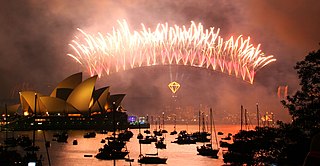
Fireworks are a class of low explosive pyrotechnic devices used for aesthetic and entertainment purposes. They are most commonly used in fireworks displays, combining a large number of devices in an outdoor setting. Such displays are the focal point of many cultural and religious celebrations, though mismanagement could lead to fireworks accidents.
Tubes and primers are used to ignite the propellant in projectile weapons.

Pyrotechnics is the science and craft of creating such things as fireworks, safety matches, oxygen candles, explosive bolts and other fasteners, parts of automotive airbags, as well as gas-pressure blasting in mining, quarrying, and demolition. This trade relies upon self-contained and self-sustained exothermic chemical reactions to make heat, light, gas, smoke and/or sound. The name comes from the Greek words pyr ("fire") and tekhnikos.

A skyrocket is a type of firework that uses a solid-fuel rocket to rise quickly into the sky; a bottle rocket is a small skyrocket. At the apex of its ascent, it is usual for a variety of effects to be emitted. Skyrockets use various stabilisation techniques to ensure the flight follows a predictable course, often a long stick attached to the side of the motor, but also including spin-stabilisation or fins.

A firecracker is a small explosive device primarily designed to produce a large amount of noise, especially in the form of a loud bang, usually for celebration or entertainment; any visual effect is incidental to this goal. They have fuses, and are wrapped in a heavy paper casing to contain the explosive compound. Firecrackers, along with fireworks, originated in China.

A gerb is a type of firework which produces a jet of sparks, usually lasting between 15 and 60 seconds. It is a thick-walled tube filled with pyrotechnic composition and possessing a choke, which is a narrowing in the tube. Gerbs are often referred to as 'fountains'.
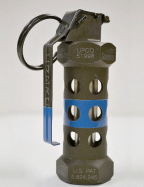
A stun grenade, also known as a flash grenade, flashbang, thunderflash, or sound bomb, is a less-lethal explosive device used to temporarily disorient an enemy's senses. Upon detonation, a stun grenade produces a blinding flash of light and an extremely loud "bang". They are often used in close-quarters combat, door breaching, and riot control, typically to stun enemies or distract them.

Smokeless powder is a type of propellant used in firearms and artillery that produces less smoke and less fouling when fired compared to black powder. Because of their similar use, both the original black powder formulation and the smokeless propellant which replaced it are commonly described as gunpowder. The combustion products of smokeless powder are mainly gaseous, compared to around 55% solid products for black powder. In addition, smokeless powder does not leave the thick, heavy fouling of hygroscopic material associated with black powder that causes rusting of the barrel.
In pyrotechnics a salute is a device primarily designed to make a loud report (bang), rather than have a visual effect, although most salutes also have a bright flash. They most commonly consist of a 70:30 mixture of potassium perchlorate and dark aluminium powder and may have titanium added for a cloud of sparks. The salute may be fired on the ground or launched from a mortar as a shell. Due to the nature of the effect, large salutes are some of the more hazardous fireworks.

Flash powder is a pyrotechnic composition, a mixture of oxidizer and metallic fuel, which burns quickly (deflagrates) and produces a loud noise regardless of confinement. It is widely used in theatrical pyrotechnics and fireworks and was once used for flashes in photography.
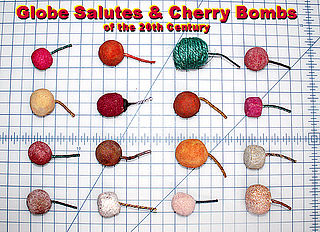
A cherry bomb is an approximately spherical exploding firework, roughly resembling a cherry in size and shape. Cherry bombs range in size from three-quarters to one and a half inches in diameter.

Fireworks in England, Scotland and Wales are governed primarily by the Fireworks Regulations 2004, the Pyrotechnic Articles (Safety) Regulations 2015, and British Standards BS 7114 until 4/7/17 and BS-EN 15947-2015. In Northern Ireland, fireworks are governed by The Pyrotechnic Articles (Safety) Regulations 2015, and Explosives (Fireworks) Regulations (NI) 2002.

A contact explosive is a chemical substance that explodes violently when it is exposed to a relatively small amount of energy. Though different contact explosives have varying amounts of energy sensitivity, they are all much more sensitive relative to other kinds of explosives. Contact explosives are a part of a group of explosives called primary explosives, which are also very sensitive to stimuli but not to the degree of contact explosives. The extreme sensitivity of contact explosives is due to either chemical composition, bond type, or structure.

A rocket is a pyrotechnic firework made out of a paper tube packed with gunpowder that is propelled into the air. Types of rockets include the skyrockets, which have a stick to provide stability during airborne flight; missiles, which instead rotate for stability or are shot out of a tube; and bottle rockets, smaller fireworks – 1½ in (3.8 cm) long, though the attached stick extends the total length to approximately 12 in (30 cm) – that usually contain whistle effects.
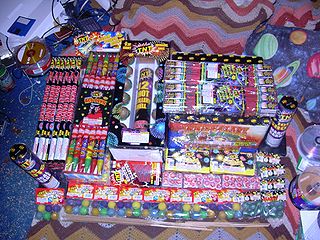
Consumer fireworks are fireworks sold for use by the general public. They are generally weaker in explosive power than the fireworks used in professional displays.

M-80s are an American class of large powerful firecrackers, sometimes called salutes. M-80s were originally made in the mid 20th century for the U.S. military to simulate explosives or artillery fire. The "M" is designated by a U.S. military convention for "standard" equipment and "80" is for the 80 grains of flash powder within it. Later, M-80s were manufactured as consumer fireworks made from a small cardboard tube, often red, approximately 1+1⁄2 inches (3.8 cm) long and 9⁄16 inch (1.4 cm) inside diameter, with a fuse coming out of the side; this type of fuse is commonly known as cannon fuse or Visco fuse, after a company responsible for standardizing the product. This consumer version holds a reduced charge of 45 grains of pyrotechnic flash powder.
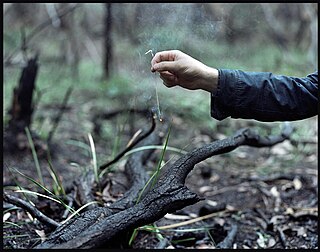
Senko hanabi is a traditional Japanese firework. Essays about them date back to at least 1927.
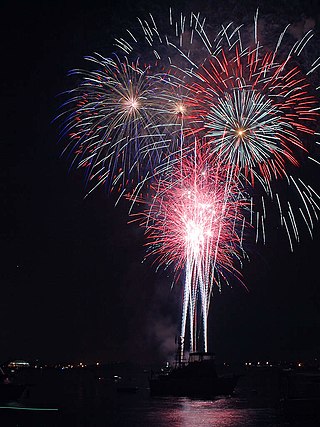
Fireworks policy in the United States can be different in each jurisdiction.

















